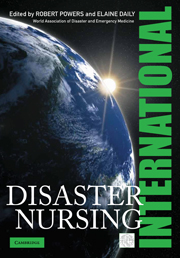Book contents
- Frontmatter
- FOREWORD I
- FOREWORD II
- Contents
- CONTRIBUTORS
- PREFACE
- ACKNOWLEDGMENTS
- CHAPTER 1 INTRODUCTION TO DISASTERS AND DISASTER NURSING
- CHAPTER 2 HEALTHCARE FACILITY PREPAREDNESS
- CHAPTER 3 COMMUNITY BEHAVIOR AND RESPONSE TO DISASTER
- CHAPTER 4 FIRST RESPONDERS
- CHAPTER 5 DISASTER TRIAGE
- CHAPTER 6 HOSPITAL IMPACT: EMERGENCY DEPARTMENT
- CHAPTER 7 HOSPITAL IMPACT: IMMEDIATE ISSUES
- CHAPTER 8 HOSPITAL IMPACT: LONG-TERM ISSUES
- CHAPTER 9 HOSPITAL IMPACT: INTERNAL DISASTERS
- CHAPTER 10 HEALTHCARE FACILITIES INCIDENT COMMAND
- CHAPTER 11 CHEMICAL PREPAREDNESS AND RESPONSE
- CHAPTER 12 BIOLOGICAL PREPAREDNESS AND RESPONSE
- CHAPTER 13 EMERGENCY MANAGEMENT OF RADIATION INJURIES AND ILLNESSES
- CHAPTER 14 EXPLOSIVE EVENT PREPAREDNESS/RESPONSE
- CHAPTER 15 DECONTAMINATION
- CHAPTER 16 POPULATIONS WITH VULNERABILITIES AND SPECIAL NEEDS
- CHAPTER 17 DISASTERS AND CHILDREN
- CHAPTER 18 REGIONAL PLANNING
- CHAPTER 19 US FEDERAL RESOURCES AND RESPONSE
- CHAPTER 20 INTERNATIONAL DISASTER RESPONSE
- CHAPTER 21 DISASTER NURSING RESPONSES IN JAPAN
- CHAPTER 22 PREPAREDNESS OF THE ISRAELI HEALTH SYSTEM FOR EMERGENCIES
- CHAPTER 23 PUBLIC HEALTH RESPONSE
- CHAPTER 24 PANDEMIC PLANNING
- CHAPTER 25 HEALTH ISSUES IN HUMANITARIAN EMERGENCIES
- CHAPTER 26 DISASTER MENTAL HEALTH
- CHAPTER 27 DISASTER ETHICS
- CHAPTER 28 DISASTER RECOVERY
- CHAPTER 29 THE SOUTHEAST ASIA TSUNAMI: HEALTH ASPECTS
- CHAPTER 30 HURRICANE KATRINA: HEALTH ASPECTS
- CHAPTER 31 DISASTER NURSING EDUCATIONAL COMPETENCIES
- CHAPTER 32 DISASTER NURSING RESEARCH
- CHAPTER 33 DISASTER RESEARCH FRAMEWORK
- INDEX
CHAPTER 30 - HURRICANE KATRINA: HEALTH ASPECTS
Published online by Cambridge University Press: 02 December 2010
- Frontmatter
- FOREWORD I
- FOREWORD II
- Contents
- CONTRIBUTORS
- PREFACE
- ACKNOWLEDGMENTS
- CHAPTER 1 INTRODUCTION TO DISASTERS AND DISASTER NURSING
- CHAPTER 2 HEALTHCARE FACILITY PREPAREDNESS
- CHAPTER 3 COMMUNITY BEHAVIOR AND RESPONSE TO DISASTER
- CHAPTER 4 FIRST RESPONDERS
- CHAPTER 5 DISASTER TRIAGE
- CHAPTER 6 HOSPITAL IMPACT: EMERGENCY DEPARTMENT
- CHAPTER 7 HOSPITAL IMPACT: IMMEDIATE ISSUES
- CHAPTER 8 HOSPITAL IMPACT: LONG-TERM ISSUES
- CHAPTER 9 HOSPITAL IMPACT: INTERNAL DISASTERS
- CHAPTER 10 HEALTHCARE FACILITIES INCIDENT COMMAND
- CHAPTER 11 CHEMICAL PREPAREDNESS AND RESPONSE
- CHAPTER 12 BIOLOGICAL PREPAREDNESS AND RESPONSE
- CHAPTER 13 EMERGENCY MANAGEMENT OF RADIATION INJURIES AND ILLNESSES
- CHAPTER 14 EXPLOSIVE EVENT PREPAREDNESS/RESPONSE
- CHAPTER 15 DECONTAMINATION
- CHAPTER 16 POPULATIONS WITH VULNERABILITIES AND SPECIAL NEEDS
- CHAPTER 17 DISASTERS AND CHILDREN
- CHAPTER 18 REGIONAL PLANNING
- CHAPTER 19 US FEDERAL RESOURCES AND RESPONSE
- CHAPTER 20 INTERNATIONAL DISASTER RESPONSE
- CHAPTER 21 DISASTER NURSING RESPONSES IN JAPAN
- CHAPTER 22 PREPAREDNESS OF THE ISRAELI HEALTH SYSTEM FOR EMERGENCIES
- CHAPTER 23 PUBLIC HEALTH RESPONSE
- CHAPTER 24 PANDEMIC PLANNING
- CHAPTER 25 HEALTH ISSUES IN HUMANITARIAN EMERGENCIES
- CHAPTER 26 DISASTER MENTAL HEALTH
- CHAPTER 27 DISASTER ETHICS
- CHAPTER 28 DISASTER RECOVERY
- CHAPTER 29 THE SOUTHEAST ASIA TSUNAMI: HEALTH ASPECTS
- CHAPTER 30 HURRICANE KATRINA: HEALTH ASPECTS
- CHAPTER 31 DISASTER NURSING EDUCATIONAL COMPETENCIES
- CHAPTER 32 DISASTER NURSING RESEARCH
- CHAPTER 33 DISASTER RESEARCH FRAMEWORK
- INDEX
Summary
HURRICANE KATRINA CAME ASHORE in New Orleans, Louisiana, on Monday, 29 August 2005. This Category 4 storm was the most destructive natural event in US history, and caused destruction in four states (Louisiana, Mississippi, Florida, and Alabama) that totaled 90,000 square miles, an area the size of the United Kingdom. In New Orleans, the massive rainfall resulted in the breaching of the city's levees with flooding that devastated the area's medical and public health infrastructure. Overall, more than 1,800 deaths were caused by Hurricane Katrina and the subsequent flooding, and emergency officials “faced extraordinary de-mands for health services, including evacuation of thousands of hospital and nursing home patients”. Tens of thousands of individuals needed medical care following Hurricane Katrina, and >200,000 individuals with chronic medical conditions were without access to medications and the healthcare systems where they normally received care. While many public health and medical challenges are expected in any disaster, the scope of the damage from these two events (the hurricane and the failure of the levees) posed unique response challenges, such as the loss or separation of medical records from patients, evacuation of medically fragile patients from flooded medical facilities, crippled communication systems, and the destruction of critical medical and public health infrastructure.
This chapter reviews the medical responses to Hurricane Katrina, and presents lessons learned for consideration in disaster planning.
- Type
- Chapter
- Information
- International Disaster Nursing , pp. 529 - 548Publisher: Cambridge University PressPrint publication year: 2010



